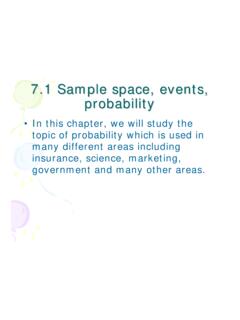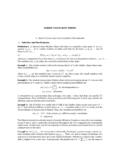Transcription of 10.1 Properties of Markov Chains - Governors State University
1 Properties of Markov Chains In this section, we will study a concept that utilizes a mathematical model that combines probability and matrices to analyze what is called a stochastic process, which consists of a sequence of trials satisfying certain conditions. The sequence of trials is called a Markov Chainwhich is named after a Russian mathematician called Andrei Markov (1856-1922). Andrei Markov (1856-1922) ~history/ { Markov is particularly remembered for his study of Markov Chains , sequences of random variables in which the future variable is determined by the present variable but is independent of the way in which the present State arose from its predecessors. This work launched the theory of stochastic processes Transition probability matrix: Rows indicate the current State and column indicate the transition.}
2 For example, given the current State of A, the probability of going to the next State A is s. Given the current State A , the probability of going from this State to A is r. Notice that the rows sum to 1. We will call this matrix P. Initial State distribution matrix: {This is the initial probabilities of being in State A as well as not A , A . Notice again that the row probabilities sum to one, as they should. []= 0'1 AASttFirst and second State matrices: {If we multiply the Initial State matrix by the transition matrix, we obtain the first State matrix.{If the first State matrix is multiplied by the transition matrix we obtain the second State matrix: =1oSSP== =2210oSSPSPPSPKth State matrix{If this process is repeated we will obtain the following expression: The entry in the ithrow and jthcolumn indicates the probability of the system moving from the i thstate to the j thstate in k observations or trials.}}}}
3 =0kSP =1kkSSPAn example: An insurance company classifies drivers as low-risk if they are accident-free for one year. Past records indicate that 98% of the drivers in the low-risk category (L) will remain in that category the next year, and 78% of the drivers who are not in the low-risk category ( L ) one year will be in the low-risk category the next year. the transition matrix, P 90% of the drivers in the community are in the low-risk category this year, what is the probability that a driver chosen at random from the community will be in the low-risk category the next year? The year after next ? (answer , from matrices) = ' ' []=0' []=1' =2210oSSPSPPSP[]=2' the kth State matrix {Use the formula to find the 4thstate matrix for the previous problem.}
4 {={after four states, the percentage of low-risk drivers has increased to .97488=0kkSSP=440 SSP[] []. Regular Markov ChainsIn this section, we will study what happens to the entries in the kthstate matrix as the number of trials increases. We wish to determine the long-run behavior of the both the State matrices and the powers of the transition matrix P. Stationary Matrix {When we computed the fourth State matrix of a previous problem we saw that the numbers appeared to approaching fixed values. Recall, {We would find if we calculated the 5th, 6thand and kthstate matrix, we would find that they approach a limiting matrix of [ ] This final matrix is called a stationary matrix. {=440 SSP[] [].}}}}}
5 Matrix {The stationary matrix for a Markov chain with transition matrix P has the property that SP = S{To prove that the matrix [ ]is the stationary matrix, we need to show that SP = S{={Upon multiplication, we find the above statement to be true, so the stationary matrix is [ ][] [] matrix concept{What this means is that in the long-run the system will be at a steady State . Later states will change very little, if at all. This means that in the long run , the number of low-risk drivers will be and the number of drivers which are not low-risk will be {The question of whether or not every Markov chain has a unique stationary matrix can be answered- it is no. However, if a Markov chain is regular , then it will have a unique stationary matrix and successive State matrices will always approach this stationary matrix.}}}}}}
6 Regular Markov Chains {A transition matrix P is regularif some power of P has only positive entries. A Markov chain is a regular Markov chain if its transition matrix is regular. For example, if you take successive powers of the matrix D, the entries of D will always be positive (or so it appears). So D would be regular.{D = = . = ..21 DProperties of Regular Markov Chains {If a Markov chain is regular (that is, it has a transition matrix, P, that is regular (successive powers of this matrix P contains only positive entries)) then {there is a unique stationary matrix S that can be found by solving the equation{SP = S Finding the stationary matrix. We will find the stationary matrix for the matrix we have just identified as regular: SP = S , where {Solve the system below:{Thus, S = [ ] = []=12 Sss[]12ss []=12ss[][]++= += = += += 1211212 1211211 sssif ssss ssLimiting matrix P to the power k {According to theorem 1 of this section, the State matrices S k will approach the stationary matrix S and the matrices given by successive powers of P approach a limiting matrix P* where each row of P* is equal to the stationary matrix S.}}}}}}}}
7 {S =[] = * Absorbing Markov ChainsIn this section, the concepts of absorbing Markov Chains will be discussed and illustrated through examples. We will see that the powers of the transition matrix for an absorbing Markov chain will approach a limiting matrix. We must introduce some terminology first. Absorbing State and Absorbing Chains {A State in a Markov chain is called an absorbing stateif once the State is entered, it is impossible to leave. {This concept will be illustrated by an example: For the following transition matrix, we determine that B is an absorbing State since the probability from going from State B to State B is one (this means that once the system enters State B it does not leave since the probability of moving from State B to states A or C is zero as indicated by the second row.)}}}
8 Theorem 1:Absorbing states and transition matrices {A State in a Markov chain is absorbingif and only if the row of the transition matrix corresponding to the State has a 1 on the main diagonal and zeros elsewhere. {To ensure that the transition matrices for Markov Chains with one or more absorbing states have limiting matricesit is necessary that the chain satisfies the following definition: {A Markov chain is an absorbing chain if: {A) there is at least one absorbing State . {B) It is possible to go from each non-absorbing State to at least one absorbing State in a finite number of steps. Recognizing Absorbing Markov Chains {We will use a transition diagram to determine whether P is the transition matrix for an absorbing Markov chain .}}}}}}
9 = We see that B is an absorbing stateIn a transition matrix, if all the absorbing states precede all the non-absorbing states, the matrix is said to be in standard form. Standard forms are very useful in determining limiting matrices for absorbing Markov Chains . {The matrix below is in standard form since the absorbing states A and B precede the non-absorbing State C. The general standard form matrix P is listed on the right in which the matrix P is partitioned into four sub-matrices I, O , R and Q where I is an identity matrix and O is the zero matrix. 0 IPRQ = Limiting Matrix {We are now ready to discuss the long-run behavior of absorbing Markov Chains . This will be illustrated with an application.}}
10 {Two competing real estate companies are trying to buy all the farms in a particular area for future housing development. Each year, 10% of the farmers sell to company A each year, 40% sell to company B and the remainder continue farming. Neither company ever sells any of the farms they purchase. {A) Draw a transition diagram for this Markov process and determine whether the associated Markov chain is absorbing. {B) Write a transition matrix in standard form {C) If neither company owns any farms at the beginning of this competitive buying process, estimate the percentage of farms that each company will purchase in the long run. Transition DiagramWe see that states A and B are absorbing. We also see that the associated Markov chain is absorbing, since there are two absorbing states A and B and it is possible to go from the non-absorbing State C to either A or B in one use the transition diagram to write a transition matrix that is in standard form: {.}}}}}















